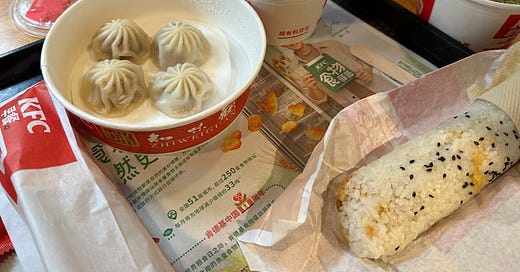Guan Yang (GY) is a data scientist based in New York. He wrote the epic Dogal Elections Edition.
Guan here. These are two breakfasts I had at KFC in China last year:
Why is this interesting?
Globally successful fast food chains often supplement their core offerings with localized menu items. There are croissants and baguettes at McDonald’s France, and the classic bøfsandwich that McDonald’s offered seasonally back in Denmark.
For dinner, KFC in China adds various rice and noodle dishes, and Macanese egg tarts, to the usual fried chicken and sandwiches. For lunch and dinner, eaters are more adventurous and Chinese are just as likely to crave a juicy burger or chicken thigh as an American is to dig into Sichuanese hot pot. For breakfast, though, we crave the foods we are used to. Unless you are from England, the “full English” is a fun weekend brunch experience, but it is not what you instinctively seek out to start a big day.
Chinese consumers are increasingly embracing coffee culture, with foreign chains like Tim Horton’s, homegrown ones such as Luckin and local independent coffee shops all expanding rapidly. Tellingly, most of these new coffee shops don’t do much early morning business, with the new cafés opening at 7:30 or 8 or even as late as 10. Morning routines change slowly.
That’s why KFC takes their Chinese breakfast menu to another level, with rice balls, soup dumplings (xiaolongbao), multiple types of congee, youtiao and salted eggs, along with the obligatory freshly prepared soy milk. A scroll through a Chinese KFC menu reveals many more local options for breakfast than lunch or dinner. (McDonald’s does have youtiao, but not any congee or soup dumplings.)
I don’t know what it takes to prepare soup dumplings in a fast food kitchen, and they may well be frozen or semi-prepared, but they tasted quite reasonable to me. All this helps explain why KFC is number 1 in the Chinese fast food market.
US-based multinational companies like to do a tax inversion, becoming Irish to avoid taxes. 7-Eleven is now essentially (and legally) a Japanese chain, with a strange American version that sells hydrocarbons in addition to carbohydrates. KFC has undergone a culinary inversion and is now, at its core, a Chinese breakfast chain, with the American offshoot a strange imitation of the mother ship. Especially since Popeyes is better for the core chicken product. (GY)
WITI Classifieds:
We are experimenting with running some weekly classifieds in WITI. If you’re interested in running an ad, you can purchase one through this form. If you have any questions, don’t hesitate to drop a line.
Interpreting the internet for the tasteful reader. Join 23,000+ subscribers who rely on Dirt for their cultural alpha. Subscribe for free.
Quick Links:
Cultural boon or abomination? American-Chinese food arrives in Beijing
How China’s hottest social media app turned Düsseldorf into a foodie destination
—
Thanks for reading,
Noah (NRB) & Colin (CJN) & Guan (GY)
—
Why is this interesting? is a daily email from Noah Brier & Colin Nagy (and friends!) about interesting things. If you’ve enjoyed this edition, please consider forwarding it to a friend. If you’re reading it for the first time, consider subscribing.







Guan, are you aware of regional variations in the KFC breakfast menu? The cifantuan (rice balls) and xiaolongbao (soup dumplings) are most popular in the east, so I wonder if they offer those in other regions.